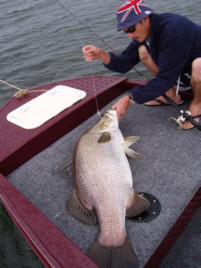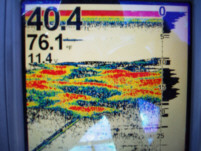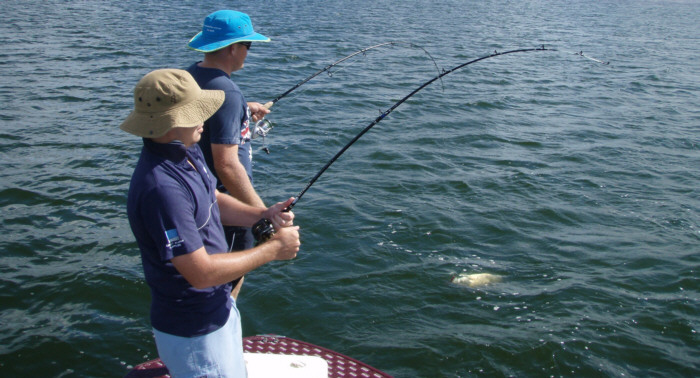Distant
sea eagles converse in harmony, relaxed in their distinguished
province. Autumn is approaching. A faint afternoon sea breeze
tickles the lake's surface camouflaging the periodic splashes
from the sub surface fish activity; boney bream are on the hunt.
Pelicans and cormorants clearly flock in droves on a sun warmed
lake as mysterious clouds form above. Wading birds toil feverishly
on the shores, nature is certainly alive today. Submersed and
attentive, barra lay in sociable arrangement, those recharging
and in need of energy eager to make the most of this golden weather
opportunity. Food is on the minds of many.
Fading light and a setting sun highlight the striking end to a
beautiful day and as night falls the land cools and amidst the
ritual, a downward spiral in surface water temperature transpires.
A forth coming cool weather change kicks in by midnight with fresh
and cold southerly winds biting their way across the state, destroying
any positive feeling of warmth and kindness. Daylight emerges
on a bitter lake, rough, wet and very uninviting. Birds huddle
in numbers resting on the shoreline, many asleep, their heads
tucked under their wings. The skies are a vibrant blue and the
forever present cattle seem to have moved away to more favourable
territory. Nature has fashioned an abrupt change.
My only constant digital updates on the depth sounder show a lake
surface temperature well down from that of yesterday. Bait schools
seem moderately packed, and they seem to be holding deeper within
the core of the lake. At this moment, barra are no where to be
seen. The weather has re-molded our lake system completely, it
is back to the beginning once again. A new home for fishes has
been designed.
|
Larger
fish require greater volumes of energy to exist. Water temperature
fluctuation will see the metabolism of barra rise and fall
accordingly. Digestion processes are altered with these
changes, and along with these changes comes variances with
response to food intake/lure strikes. Eventually, individual
fish will feel the urge to feed and act accordingly. All
barra do not feed on the same day. Other fish may be satsified
and lay idle for lengthy periods until once again the need
for energy kicks in.
|
 |
Click
on image for larger version
Barramundi
are forced to live in our freshwater landlocked environments.
They have no choice; they need to make the most of the best opportunities
that exist, to stay alive. Its do or die, it is as simple as that.
Nature has many ways of altering living circumstances for many
animals, underwater is no exception. Seasonal weather changes
and geological and biological changes within a lake system will
dominate the living circumstances for those creatures within.
The fact is that our barra lakes are constantly evolving fish
homes, not only from a visual topographic aspect, but from a water
quality perspective as well. No two days are ever the same in
any waterway. Opportunities that existed briefly yesterday may
no longer exist. Through the strive for survival, impoundment
barramundi will seek and learn what occurs in their own home waters
because of one major fixation, their nomadic and peripatetic ways.
Salt or fresh, the barramundi is not the full time snag dweller
that it is made out to be. Their natural body armour of large
scales, sharp spikes and their tough, muscular general appearance
and powerful tail expose them as an animal designed to take charge.
They wander, move, search and discover options in life that a
stationary individual would not be aware of. They are learners
and willing participants in the game of life. In a perfect world,
living creatures have optimum running temperatures, yet in lake
systems with extremes of contrast, those optimum temperature levels
may never or rarely be available. Humans, we can live in a t-shirt
in the tropics or a t-shirt in the south of our country. We can
tolerate circumstances less favourable, so too can landlocked
barramundi. They operate in extremes, fine lines of extremes.
|
Barramundi
will seek ideal circumstances within enclosed lake systems.
This sounded image shows large numbers of maturing barra
holding in an ideal water layer between 10ft and 20ft below
the surface, (3-6 metres down). Water quality and testing
equipment helps give an insight into why fish may congregate
in such regions. Temperature stability is a main factor,
oxygen levels and Ph alterations can also influence fish
distribution. Data logging devices deployed and sumbmersed
for a period of over 6 months at 3 different water depths
show interesting results over time. At certain times of
the year, late May and June especially, water temperatures
can be almost equal (less than point one of a degree celsius)
from the surface to the bottom of the lake in depths of
up to 60ft,18 metres.
|
 |
Click
on image for larger version
Barramundi
are assorted in distribution within lakes because barramundi do
not all feed at the same time nor in the same place or on the
same day. Fish vary in size, age, condition, health, and are always
at varying stages of digestion. Dinner bells ring constantly in
lakes and each fish has its turn to feed when the urge creeps
in or when opportunity arises. Barra that you encounter today
may well be in a 'sleep like' torpor tomorrow and those that rest
will naturally come into hunger mode when time allows. Like shift
workers, barra will work on a tag team system, including 3 activities
such as hunting and wandering, resting, and recharging/digesting.
So it is never fair to mention or generalize on what barra will
be doing as not only are they constantly separated into groups
via the digestion phase, but they are also categorized into size
classes that all run on different energy requirements. Metre long
barramundi require different water qualities and food volumes
to exist than that of 70cm barramundi. From the 12 yr classes
of barramundi released into Awoonga, I have noted strong separations
in conduct and distribution that can easily allow them to be placed
into another 7 distinct groups. So now, 7 distinctly dissimilar
groups of fish all with divergent power systems that can all be
in one of say 3 different levels of a digestion phase which ultimately
will see them in assorted states of mentality and compliance.
You could say that at least 21(7 x3) possible 'forms' of barra
mode could exist in Awoonga at any given time. Metabolic rates
adjusted by water temperature alterations also affect this dynamic,
but does not affect every fish in the same way.
Try advancing a few extra thoughts into why and where barra are
distributed in lakes and why such diverse fishing methods can
be applied to catch the stocked species. Imagine the changes that
occur to the water they live in from weather alterations and then
think of changes in water temperature, metabolism, and therefore
digestion processes and see if any of those combinations might
help you to understand why this special fish of interest often
mixes it up to test us all and to keep us on our toes.
Designed to keep the mind in forward gear!







